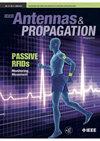Pioneering the Method of Moments [Editor’s Comments]
IF 4.2
4区 计算机科学
Q2 ENGINEERING, ELECTRICAL & ELECTRONIC
引用次数: 0
Abstract
Any member of our Society is very well aware of the key role that electromagnetic modeling plays in advanced electromagnetic engineering, and the method of moments (MoM), often known also as the开创 "瞬间法"[编者的话]
我们协会的任何成员都非常清楚电磁建模在高级电磁工程中的关键作用,而矩量法(MoM),通常也称为边界元法(BEM),是最流行和最广泛的技术之一。这种计算策略是由 Roger F. Harrington 教授在电磁学领域开创的,一代又一代的研究人员和从业人员都深深地感谢这位科学家。在本期的《IEEE 天线与传播》杂志上,胡安-莫西格教授[A1]、[A2]分两部分向这位杰出的科学先驱致敬,并以一种最佳方式表达了敬意:对静态(第 1 部分)和动态(第 2 部分)情况下的 MOM/BEM 进行了全面回顾。对于任何有兴趣了解更多信息和进行相关研究的人来说,这篇宝贵的文章都是一个相当方便和全面的起点。我们希望您会喜欢这些文章,并确保同时查看在线补充材料!
本文章由计算机程序翻译,如有差异,请以英文原文为准。
求助全文
约1分钟内获得全文
求助全文
来源期刊

IEEE Antennas and Propagation Magazine
工程技术-工程:电子与电气
CiteScore
7.00
自引率
5.70%
发文量
186
审稿时长
3 months
期刊介绍:
IEEE Antennas and Propagation Magazine actively solicits feature articles that describe engineering activities taking place in industry, government, and universities. All feature articles are subject to peer review. Emphasis is placed on providing the reader with a general understanding of either a particular subject or of the technical challenges being addressed by various organizations, as well as their capabilities to cope with these challenges. Articles presenting new results, review, tutorial, and historical articles are welcome, as are articles describing examples of good engineering. The technical field of interest of the Magazine is the same as the IEEE Antennas and Propagation Society, and includes the following: antennas, including analysis, design, development, measurement, and testing; radiation, propagation, and the interaction of electromagnetic waves with discrete and continuous media; and applications and systems pertinent to antennas, propagation, and sensing, such as applied optics, millimeter- and sub-millimeter-wave techniques, antenna signal processing and control, radio astronomy, and propagation and radiation aspects of terrestrial and space-based communication, including wireless, mobile, satellite, and telecommunications.
 求助内容:
求助内容: 应助结果提醒方式:
应助结果提醒方式:


